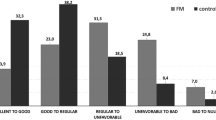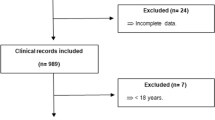Abstract
Background
Fibromyalgia (FM) is characterized by chronic and widespread pain, sleep disturbances, fatigue, psychological distress and morning stiffness. These patients also present symptoms such as depression, sexual dysfunctions and reproductive problems. Sexuality involves several aspects, including pelvic floor functionality, and one question is whether the sexual performance of women with fibromyalgia is associated with pelvic floor function or other characteristics of the disease.
Objective
The aim of this study was to gauge the association between perineal function and sexual performance in women with and without fibromyalgia.
Methods
We performed a cross-sectional study with 109 sexually active women from 19 to 65 years of age, either suffering from fibromyalgia (FM group, n = 51) or free from fibromyalgia (non-FM group, n = 58). Perineal function was measured with the use of perineometry and digital vaginal palpation (PERFECT Scheme), while sexual performance was assessed by the Sexual Quotient Female questionnaire (QS-F).
Results
Patients with fibromyalgia presented poor sexual performance compared to those without fibromyalgia (QS-F score 58 (32–66) vs. 66 (56–70); p = 0.002) as well as lower pelvic floor muscle strength measured by perineometry (32.5 (18.2–40.5) vs. 37.9 (23.4- 57.3); p = 0.03). Patients without fibromyalgia presented a positive correlation between perineometry and QS-F (r = 0.22; p = 0.038), while those with fibromyalgia presented no correlation between those two variables (r = 0.22; p = 0.12). The regression model showed an association between sexual performance and the presence of fibromyalgia, pelvic floor muscle strength (perineometry) and age, according to the following equation: sexual performance = 48.52 + (9.5 * non-FM group) + (0.23 * perineometry)–(0.4 * age), with adjusted R2 = 0.19.
Conclusion
Women with FM present poor sexual performance and lower pelvic floor muscle strength compared to those without FM. However, the correlation between these variables among women without FM was not observed in women with FM. Sexual performance showed a positive association with absence of fibromyalgia and higher pelvic floor muscle strength, and a negative association with age.

Similar content being viewed by others
References
Wolfe F, Clauw DJ, Fitzcharles MA, Goldenberg DL, Katz RS, Mease P et al (2010) The American College of Rheumatology preliminary diagnostic criteria for fibromyalgia and measurement of symptom severity. Arthritis Care Res (Hoboken) 62(5):600–610. https://doi.org/10.1002/acr.20140
Alves B, Zakka TM, Teixeira MJ, Kaziyama HH, Siqueira JT, Siqueira SR (2016) Depression, sexuality and fibromyalgia syndrome: clinical findings and correlation to hematological parameters. Arq Neuropsiquiatr 74(11):863–868. https://doi.org/10.1590/0004-282X20160141
CeC F, da Mota LM, Oliveira AC, de Carvalho JF, Lima RA, Simaan CK et al (2013) Frequency of sexual dysfunction in women with rheumatic diseases. Rev Bras Reumatol 53(1):35–46. https://doi.org/10.1590/S0482-50042013000100004
Abdo CHN (2006) Development and validation of female sexual quotient—a questionnaire to assess female sexual function. Rev Bras Med 63(9):477–482
Basson R, Gilks T (2018) Women's sexual dysfunction associated with psychiatric disorders and their treatment. Womens Health (Lond) 14:1745506518762664. https://doi.org/10.1177/1745506518762664
Matarín Jiménez TM, Fernández-Sola C, Hernández-Padilla JM, Correa Casado M, Antequera Raynal LH, Granero-Molina J (2017) Perceptions about the sexuality of women with fibromyalgia syndrome: a phenomenological study. J Adv Nurs 73(7):1646–1656. https://doi.org/10.1111/jan.13262
Rico-Villademoros F, Calandre EP, Rodríguez-López CM, García-Carrillo J, Ballesteros J, Hidalgo-Tallón J et al (2012) Sexual functioning in women and men with fibromyalgia. J Sex Med 9(2):542–549. https://doi.org/10.1111/j.1743-6109.2011.02513.x
Besiroglu MDH, Dursun MDM (2019) The association between fibromyalgia and female sexual dysfunction: a systematic review and meta-analysis of observational studies. Int J Impot Res 31(4):288–297. https://doi.org/10.1038/s41443-018-0098-3
Fusco HCSC, Pontes Filho MAG, Haddad JM, Zanetti MRD, Marques AP, Ferreira EAG (2019) Lower urinary tract symptoms and perineal function in women with and without fibromyalgia: a cross-sectional study. Clin Rheumatol. 38(10):2885–2890. https://doi.org/10.1007/s10067-019-04617-y
Baracho E (2018) Fisioterapia aplicada a saúde da mulher. Grupo Editoral Nacional, São Paulo
Laycock J, Jewood D (2001) Pelvic floor muscle assessment: the PERFECT scheme. Physiotherapy 87(12):631–642. https://doi.org/10.1016/S0031-9406(05)61108-X
Thornton KGS, Robert M (2020) Prevalence of pelvic floor disorders in the fibromyalgia population: a systematic review. J Obstet Gynaecol Can. 42(1):72–79. https://doi.org/10.1016/j.jogc.2019.02.013
Bartolami A, Vanti C, Banchelli F, Guccione AA, Pillastrini P (2015) Relationship between pelvic muscle floor dysfunction and sexual dysfunction: an observational study. J Sex Med. 12(5):1233–1241. https://doi.org/10.1111/jsm.12882
Akkaya N, Akkaya S, Atalay NS, Balci CS, Sahin F (2012) Relationship between the body image and level of pain, functional status, severity of depression, and quality of life in patients with fibromyalgia syndrome. Clin Rheumatol 31(6):983–988. https://doi.org/10.1007/s10067-012-1965-9
Kayhan F, Kuçuc A, Satan Y, Ílgün E, Arslan S, Ílik F (2016) Sexual dysfunction, mood, anxiety, and personality disorders in female patients with fibromyalgia. Neuropsychiatric Dis Treat 12:349–355. https://doi.org/10.2147/NDT.S99160
Tikiz C, Muezzinoglu T, Pirildar T, Taskn EO, Frat A, Tuzun C (2005) Sexual dysfunction in female subjects with fibromyalgia. J Urol 174(2):620–623. https://doi.org/10.1097/01.ju.0000165155.33511.eb
Jiao J, Vincent A, Cha SS, Luedtke CA, Oh TH (2015) Association of abuse history with symptom severity and quality of life in patients with fibromyalgia. Rheumatol Int 35:547–553. https://doi.org/10.1007/s00296-014-3113-0
Karaguzel EO, Karkucak M, Saglam DA, Tiryaki A, Kunahan A, Capkin E (2018) Sexual dysfunction and childhood trauma in female patients with fibromyalgia. Isr J Psychiatry Relat Sci 55(2):10–14
Acknowledgements
We thank (Coordination for the Improvement of Higher Education Personnel—Government Research Agency).
Funding
This study received funds from CAPES (Coordination for the Improvement of Higher Education Personnel—Government Research Agency) with scholarship to the first author.
Author information
Authors and Affiliations
Contributions
HCSCF: conceptualization; methodology; data collection; formal analysis and investigation; writing—original draft preparation; writing—review and editing; funding acquisition; resources. MAP-F: conceptualization; methodology; data collection; formal analysis and investigation; writing—review and editing; resources. RTC: conceptualization; methodology; formal analysis and investigation; writing—review and editing; resources. ACL: methodology; formal analysis and investigation; writing—original draft preparation; writing—review and editing. EAGF: conceptualization; methodology; formal analysis and investigation; writing—original draft preparation; writing—review and editing; funding acquisition; resources; supervision. All authors approved the final manuscript as submitted and agree to be accountable for all aspects of the work.
Corresponding author
Ethics declarations
Conflict of interest
The authors have no disclosure of potential conflicts of interest. All subjects agreed to participate and signed the Informed consent form.
Ethical approval
The Ethics Committee for Analysis of Research Projects approved this study (protocol number 40789914.1.0000.0065). All subjects agreed to participate and signed the informed consent form.
Additional information
Publisher's Note
Springer Nature remains neutral with regard to jurisdictional claims in published maps and institutional affiliations.
Rights and permissions
About this article
Cite this article
de Carvalho Fusco, H.C.S., Filho, M.A.P., Consolo, R.T. et al. Sexual performance and pelvic floor muscle strength in patients with fibromyalgia: a controlled cross-sectional study. Rheumatol Int 41, 415–421 (2021). https://doi.org/10.1007/s00296-020-04595-4
Received:
Accepted:
Published:
Issue Date:
DOI: https://doi.org/10.1007/s00296-020-04595-4




